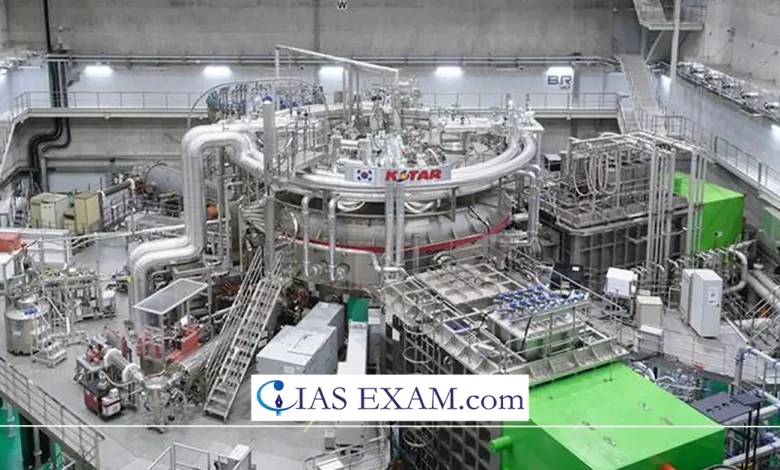
Context
Scientists in South Korea have achieved a new world record using an artificial sun nuclear fusion reactor called KSTAR. They were able to generate plasma temperatures of 100 million degrees Celsius for 48 seconds during tests conducted from December 2023 to February 2024.
Details about the South Korea achievement using Artificial Sun
-
- The Korean Superconducting Tokamak Advanced Research (KSTAR) device, often referred to as the “Artificial Sun,” has set a new world record, marking a significant milestone in the field of nuclear fusion research.
- This groundbreaking achievement has been the result of sustained efforts and technological advancements that have pushed the boundaries of what is possible in energy generation.
- The Achievement:
- On 2 April 2024, the KSTAR team announced that they had successfully sustained plasma temperatures of 100 million degrees Celsius for an unprecedented 48 seconds.
- This temperature, which is approximately seven times hotter than the core of the sun, represents the extreme conditions necessary for nuclear fusion to occur. The previous record, set in 2021, was 30 seconds, making this a substantial improvement in both the duration and stability of the plasma.
- Technological Innovations
-
-
- The success of the KSTAR reactor is attributed to several key technological innovations.
- One crucial transition was represented by the appearance of a tungsten diverter, which took the place of the carbon-based parts.
- These heat exchangers are the key elements of a fusion reactor to remove and absorb the intense heat released and propel the reaction.
- A very high Tungsten melting point gives this the quality to withstand the heat and harsh conditions inside the reactor.
-
- Significance
-
-
- The capability of maintaining such high temperatures are very critical for the success of fusion reactors.
- Fuse is the mechanism that the sun uses to supply itself. In that case, hydrogen at high pressure and temperature level comes into contact together, which leads to a large amount of energy.
- On the contrary, it is in contrast to fission, which is used in the present nuclear plants, that fusion gives a clean, safer, and positively limitless energy, with no long-lived radioactive waste.
-
- Challenges and Future Goals
-
-
- Even though the KSTAR team has made discoveries, some indiscernible obstacles arise. Keeping the high temperature plasma remains challenging since its instability nature itself therefore the process of its stabilisation becomes complex too.
- The team, in the following year, wants to increase the time maintained at these temperatures from 300 seconds to 5 minutes in 2026 which will be a major breakthrough leading to the practical applications of fusion energy.
-
- Global Impact
-
- The implications of KSTAR’s achievement are far-reaching. As the world grapples with climate change and the need for sustainable energy sources, nuclear fusion offers a promising solution.
- The progress made by the KSTAR reactor brings us closer to a future where fusion energy could be harnessed to meet global energy demands without contributing to carbon emissions.
About the Artificial Sun
- An artificial Sun typically involves creating conditions where nuclear fusion reactions can occur, primarily by heating and compressing hydrogen isotopes to extreme temperatures and pressures.
- Different techniques such as magnetic confinement (like in tokamaks) or inertial confinement (like in laser fusion) are employed to achieve the required conditions for fusion.
- The goal is to sustain controlled fusion reactions, releasing vast amounts of energy similar to the Sun, to generate clean and abundant power.
Advantages
- Abundant Energy: Fusing one atom with another can produce virtually unlimited energy because the sources of fusion fuel, such as deuterium and tritium, are nearly limitless, just like in nature.
- Clean Energy: Fusion produces energy and greenhouse gases free along with well-being wastes from the long-lived radioactive and also a smart means to deal with climate change and environmental damage.
Disadvantages
- Technical Challenges: Getting the production level of a fusion reactor high enough for overall energy generation becomes one of the most complex issues, as it requires maintaining the right conditions in the fuel core with temperatures, pressures, and stability, as well as reactor confinement.
- Cost: Constructing and operating the artificial Sun, such as ITER, projects, are capital intensive and involve the use of many valuable resources which may lead to a decrease in budget as well as an extension of timeline.
Conclusion
The recent achievement of the KSTAR reactor represents not only a significant scientific accomplishment but also offers optimism for a greener and more sustainable future. Through ongoing research and overcoming obstacles, nuclear fusion could potentially provide a game-changing energy source that transforms the global power industry.
Source: NDTV
UPSC Mains Practice Question
Q.Discuss the potential impact of artificial sun technology on global energy security, environmental sustainability, and socio-economic equity. What are the main challenges that need to be addressed to realise the full potential of fusion energy as a viable energy source on a global scale?





.png)



